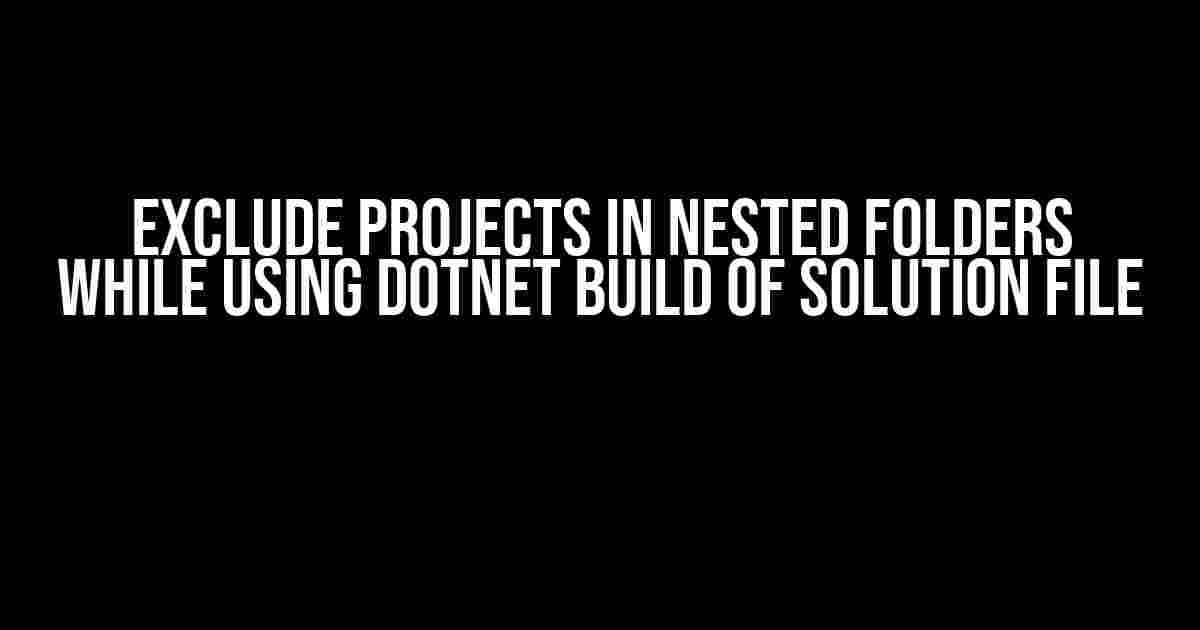Welcome to this detailed guide on how to exclude projects in nested folders while using the dotnet build command on a solution file. We’ll cover the reasons why you might want to do this, how to achieve it, and provide examples to make it crystal clear.
Why Exclude Projects in Nested Folders?
When working on a large .NET solution with multiple projects, it’s common to have a nested folder structure to keep things organized. However, when you run the dotnet build command on the solution file, it can lead to unnecessary builds of projects that you might not want to include. This can increase build times, consume more resources, and even cause conflicts.
Excluding specific projects in nested folders can help you:
- Speed up build times by reducing the number of projects being built
- Focus on building only the projects that need to be updated
- Avoid conflicts between projects with different dependencies or configurations
- Improve overall solution maintainability and scalability
Understanding the dotnet build Command
The dotnet build command is used to compile and build a .NET project or solution. When you run dotnet build on a solution file, it builds all projects in the solution, including those in nested folders. By default, the command looks for projects in the following locations:
- The directory containing the solution file
- Subdirectories of the solution file directory
- Projects referenced by other projects in the solution
To exclude projects in nested folders, we’ll modify the dotnet build command to specify which projects to include or exclude.
Excluding Projects using the –filter Option
The –filter option allows you to specify a list of projects to include or exclude from the build process. You can use this option to exclude projects in nested folders.
Syntax:
dotnet build--filter:
Example:
dotnet build MySolution.sln --filter:**/ExcludeThisProject/ *
In this example, the dotnet build command will build the MySolution.sln solution file, but exclude any projects located in a folder named “ExcludeThisProject” and its subfolders.
Project Patterns
You can use various project patterns to specify which projects to include or exclude:
| Pattern | Description |
|---|---|
| * | Matches all projects |
| **/path/to/project | Matches projects in the specified folder and its subfolders |
| !**/path/to/project | Excludes projects in the specified folder and its subfolders |
| project1;project2 | Matches specific projects (separated by semicolons) |
Example using multiple patterns:
dotnet build MySolution.sln --filter:**/ExcludeThisProject/*;!/AnotherProjectToExclude *
In this example, the dotnet build command will exclude projects in the “ExcludeThisProject” folder and its subfolders, as well as the “AnotherProjectToExclude” project specifically.
Excluding Projects using the –skip Option
The –skip option allows you to specify a list of projects to skip during the build process. This option is similar to the –filter option, but with a shorter syntax.
Syntax:
dotnet build--skip:
Example:
dotnet build MySolution.sln --skip:ExcludeThisProject *
In this example, the dotnet build command will build the MySolution.sln solution file, but skip the “ExcludeThisProject” project and its dependencies.
Specifying Multiple Projects to Skip
You can specify multiple projects to skip by separating them with commas:
dotnet build MySolution.sln --skip:ExcludeThisProject,AnotherProjectToExclude *
In this example, the dotnet build command will skip both the “ExcludeThisProject” and “AnotherProjectToExclude” projects during the build process.
Best Practices for Excluding Projects in Nested Folders
To make the most out of excluding projects in nested folders, follow these best practices:
-
Organize your solution structure by grouping related projects together in folders
-
Use descriptive folder and project names to make it easier to identify which projects to include or exclude
-
Document the excluded projects and the reasons for excluding them in your solution documentation or README file
-
Test your build process regularly to ensure that the excluded projects are not affecting the build process
-
Consider using a build script or pipeline to automate the build process and exclude projects programmatically
Conclusion
Excluding projects in nested folders while using the dotnet build command on a solution file can help you streamline your build process, reduce build times, and improve overall solution maintainability. By using the –filter or –skip options, you can specify which projects to include or exclude, and make your build process more efficient.
Remember to follow best practices, document your excluded projects, and test your build process regularly to ensure that your solution builds correctly and efficiently.
Happy building!
Frequently Asked Question
Get answers to your burning questions about excluding projects in nested folders while using dotnet build of a solution file!
How do I exclude a specific project in a nested folder from the dotnet build process?
You can exclude a specific project by using the `Remove` attribute in the `
Can I exclude multiple projects in nested folders at once?
Yes, you can exclude multiple projects by separating the project paths with a semicolon in the `ExcludeFromBuild` attribute. For example, `
How do I exclude all projects in a specific nested folder and its subfolders?
You can use the `**` wildcard to exclude all projects in a specific nested folder and its subfolders. For example, `
Can I use command-line options to exclude projects in nested folders during dotnet build?
Yes, you can use the `/p:ExcludeProjects` command-line option to exclude projects in nested folders. For example, `dotnet build /p:ExcludeProjects=”path/to/nested/project1/Folder;path/to/nested/project2/Folder”`
Will excluding projects in nested folders affect the build time and performance?
Yes, excluding projects in nested folders can significantly improve the build time and performance, especially if you have a large number of projects in your solution. By excluding unnecessary projects, you reduce the amount of work that needs to be done during the build process, resulting in faster build times and improved performance.

